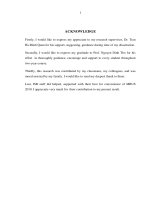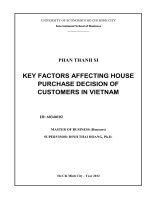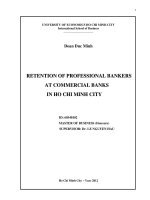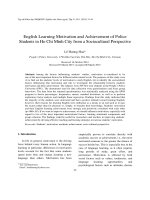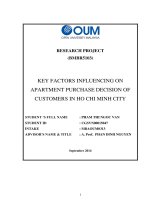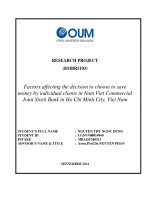Key factors influencing on apartment purchase decision of customers in ho chi minh city
Bạn đang xem bản rút gọn của tài liệu. Xem và tải ngay bản đầy đủ của tài liệu tại đây (1.58 MB, 98 trang )
1
RESEARCH PROJECT
(BMBR5103)
KEY FACTORS INFLUENCING ON
APARTMENT PURCHASE DECISION OF
CUSTOMERS IN HO CHI MINH CITY
STUDENT ‘S FULL NAME : PHAM THI NGOC VAN
STUDENT ID : CGSVN00015047
INTAKE : MBAOUM0313
ADVISOR’S NAME & TITLE : A. Prof. PHAN DINH NGUYEN
September 2014
i
Page
ADVISOR’S ASSESSMENT
Advisor’s signature
ii
ACKNOWLEDGEMENTS
First of all, I would like to express my sincere thanks to my thesis coach – A. Prof
Phan Dinh Nguyen for dedicated deep guidance, precious advice and teaching me
data analysis guidance in his precious time.
I also would like to thank you all my colleagues and friends of HUTECH class for
their valuable contributions to give comments and suggestion to revise the
questionnaire survey
Warmly thanks to my classmates, friends and all anonymous participants, and
especially my family for their supports and inspiring me to complete the MBA
course.
Sep 2014
Pham Thi Ngoc Van
iii
ABSTRACT
The speed of growing population in a recent decade together with the economic
development, the demand of housing is more and more increasing while the price of
ownership is big issue at Vietnam. Condominium is becoming the convenient living
model for people stay in big cities such as: Ha Noi, HCM and Da Nang where the
demand of living and working of immigration increasing. The beneficial view of
condominium is the residents can enjoy convenient facilities from their own
apartment to opening space with greenery system anywhere.
The demand of condominium in big cities is certain and especially at Ho Chi Minh
City where the research will pay attention real demand for middle income people.
The researcher will identify factors or determinants influence on the demand of
buying apartments at HCM City.
The study aims to identify the key factors affecting the decision of customers to buy
residential apartments in HCMC. For study purpose, a sample of 300 salaried class
persons was taken by using purposive sampling technique. The sample consisted of
those respondents who either bought an apartment or are planning to buy.
Respondents were asked to give their opinion about listed variables on Five-point
Likert Scale. By using Exploratory Factor Analysis, six factors were extracted
which explained 73.916 per cent of total variance.
iv
Contents
ADVISOR’S ASSESSMENT i
ACKNOWLEDGEMENTS ii
ABSTRACT iii
LIST OF TABLE vii
LIST OF FIGURE ix
LIST OF ABBREVIATIONS x
CHAPTER 1. INTRODUCTION 1
2.1. BACKGROUND 1
2.2. PROBLEM STATEMENT 3
2.3. RESEARCH OBJECTIVES 4
2.4. RESEARCH QUESTIONS 5
2.5. SCOPE OF STUDY 6
2.6. METHODOLOGY 6
2.7. CHAPTER OVERVIEW 7
CHAPTER 2. LITERATURE REVIEW 8
2.1. APARTMENT OVERVIEW 8
2.2. LITERATURE REVIEW 11
2.2.1. Feature 11
2.2.2. Finance 12
2.2.3. Distance 12
2.2.4. Facilities 13
2.2.5. Environment 13
2.2.6. Purchase decision 14
2.3. CONCEPTUAL FRAMEWORK 14
v
CHAPTER 3. RESEARCH METHODOLOGY 16
3.1. RESEARCH PROCESS 16
3.2. SAMPLE SIZE 19
3.3. MEASUREMENT SCALE 19
3.3.1. Measurement scale 19
3.3.2. Pilot test 19
3.4. MAIN SURVEY 22
3.5. DATA ANALYSIS METHOD 23
3.5.1. Reliability measure 23
3.5.2. Validity measure by EFA (Exploratory Factor Analysis) 23
3.5.3. Multiple regression analysis 24
CHAPTER 4. DATA ANALYSIS AND RESULTS 26
4.1. PREPARATION 26
4.1.1. Editing 26
4.1.2. Coding 26
4.2. DESCRIPTIVE DATA 29
4.3. ASSESSMENT MEASUREMENT SCALE 32
4.3.1. Cronbach’s Alpha 32
4.3.2. Exploratory Factor Analysis (EFA) 37
4.4. HYPOTHESES TESTING BY MULTIPLE REGRESSION 42
4.4.1. Checking assumption of Multiple Regression 42
4.4.2. Evaluating the model 43
4.4.3. Evaluating the independent of variables 43
4.4.4. Checking hypotheses of model 44
4.4.5. Analysis effect of control variables by Multiple Regression 46
CHAPTER 5. CONCLUSIONS AND IMPLICATIONS 47
5.1. RESEARCH OVERVIEW 47
vi
5.2. RESEARCH FINDINGS 47
5.3. MANAGERIAL IMPLICATION 48
5.4. RESEARCH LIMITATIONS & DIRECTIONS FOR FUTURE RESEARCH
HYPOTHESIS 49
REFERENCES 50
Appendix 1: Vietnamese questionnaire 64
Appendix 1: English questionnaire 69
vii
LIST OF TABLE
Table 3.1: Main factors affecting customers’ housing purchase decision 21
Table 4.1: Codebook of questionnaire items 26
Table 4.2: Characteristics of respondents 29
Table 4.3: Cronbach’s Alpha test results 34
Table 4.4: EFA results 39
Table 4.5: Correlations among variables 41
Table 4.6: Coefficient table of MLR 44
Table 4.7: Hypotheses results 45
Table 4.8: Descriptive statistics 74
Table 4.9: Cronbach’s Alpha with full items for each constructs 75
Table 4.10: KMO and Bartlett’s test 76
Table 4.11: Total variance explained 77
Table 4.12: Correlation among variables (Partial only) 78
Table 4.13: Factor Matrix 79
Table 4.14: Factor Correlation Matrix 80
Table 4.15: Model summary 80
Table 4.16: Anova 80
Table 4.17: Casewise diagnostics 81
Table 4.18: Residuals statistics 81
Table 4.19: Coefficients of MLR including Gender_Render 85
Table 4.20: Coefficients of MLR including Marital_Render 85
Table 4.21: Coefficients of MLR including Education_Render 86
viii
Table 4.22: Coefficients of MLR including Age_Render 86
Table 4.23: Coefficients of MLR including Occupation_Render 87
Table 4.24: Coefficients of MLR including Income_Render 87
ix
LIST OF FIGURE
Figure 2.1 : Research Model 15
Figure 3.1: Research process 18
Figure 4.1: Scree plot 78
Figure 4.2: Regression standardized residual 82
Figure 4.3: Normal P-P plot 83
Figure 4.4: Scatterplot 84
x
LIST OF ABBREVIATIONS
ANOVA Analysis Of Variance
CFA: Confirmatory Factor Analysis
EFA: Exploratory Factor Analysis
SPSS: Statistical Package for Social Scientists
EFA Exploratory Factor Analysis
GSO Vietnam Government Statistics Office
HCMC Ho Chi Minh City
Mil. Million
MLR Multiple Linear Regression
1
CHAPTER 1. INTRODUCTION
1.1. BACKGROUND
Vietnamese idiom says: “An cư lạc nghiệp” means that everybody wish to desire a
stable dwelling place aimed to reside peacefully in order to be a foundation to build
long term occupation. This wishing is completely satisfactory that each of us (you and
me) works hard to achieve it.
As universal population levels continue to rise, the housing shortage in many
developing countries has reached critical levels (Morel, 2001, p. 1119). Real estate is
one of the most important things to citizens, so “the house purchase decision of them
can change their life” (Wells, 1993). The house purchase decisions are different from
other business decisions due to “the innate, durable and long-term characteristics of
real estate”. It is a highly differentiated product with “each specific site unique and
fixed in location” (Kinnard, 1968).
Ho Chi Minh City, the primary economic hub for Vietnam, had a population of around
7.9 million as at December 2013. Ho Chi Minh is a biggest city of Vietnam where
people choose to live, work and reside. Therefore, demand of housing is increasing
significant while the current price of house ownership is extremely high in spite of
critical declines in real estate in recent years. And choosing apartment to reside is
emerged as a practical need of people.
First, thank for the economic growth and rapid urbanization and demand of housing
spending has been increasingly drastic in recent years. In Vietnam, the residential
market in urban areas is expanding widely. Expanding urban land supply is critical for
cities in which Vietnam requires rapidly growing urban economies with supporting
infrastructure and physical structure
In 2013, the Vietnamese economy recorded an annual growth rate of 5.42 boasting an
average annual GDP growth rate of 6.7% over the last ten years. GDP growth in 2013
was 5.4% and is expected to rise to 5.6% in 2014. Grant Thornton (2014)
2
GDP per capital of Vietnam has been growing steadily since 2000. GDP per capita has
improved steadily and in line with GDP growth since 2000. The graph below shows the
average national GDP; however, the actual GDP in cities such as Ho Chi Minh City
and Hanoi is significantly higher. (Grant Thornton, 2014)
Inflation in Vietnam averaged 7.33% from 1996 until 2013. While inflation peaked at
28.3% in August 2008, followed by inflation of 18.58% in 2011, the Vietnamese
government successfully controlled the inflation at 6.6% in 2013, the lowest rate in a
decade thanks to its monetary tightening policy. Grant Thornton (2014)
From positive signals of economic, the real estate has been started rebounding with
many projects deployed in which segment of apartment for residence is emerged
sharpen while the demand of people especially are young people is increasing.
This thesis examines housing preference of people live and work (especially urban
residents) in Ho Chi Minh City. According to the report of “Vietnam Housing Sector
Forecast to 2015” indicates the housing requirement is rising with trend of nuclear
families has created immense demand expected to grow around 6% during 2012-2015.
The condominiums in new urban areas are preferred by many young people because
the types of condominiums offer various advantages over traditional housing types
such as: lower price, good infrastructure with various facilities and services which are
suitable for the needs. The demand of young people for condominiums has been
increasing massively in recent few years.
One of the most significant economic decisions of everybody is buying a house
oneself. The need of dwelling is practical and more increasingly when the population is
growing and choosing big cities for permanent residency.
The real estate market in Vietnam has significantly changed during from the 1990s to
now and it might be seen as three times fever and declining prices in the last 20 years.
Up to the end of 2013, the large real estate outstanding loans and a big number of
inventories created a serious crisis. However, according to the Deputy Minister of
3
Construction Nguyen Tran Nam, he emphasized that “people’s housing demand is very
large and solvency is high, but the real estate market lacked of information”.
This thesis focuses on factors which influence on people's purchase decision toward
apartments / condominiums in HCM City.
1.2. PROBLEM STATEMENT
The problem here is demand of choosing condominium for residence of people in
HCM City has been emerged obviously and there are many projects of apartment and
condominium have also been developing with multi-diversified segments by both local
and international project investors, developers in a recent decade.
Therefore, the Prime Minister stressed that the solution to rescue real estate market
should be included in the Resolution of the Government. The main reasons of the crisis
were the real estate market supply did not meet customer demands, the investors lacked
of exact information of customer and real estate market conditions
In fact, the demand and the supply do not meet each other due to having some
undefined problems relating to buying decision of people as follow:
- In Vietnam, in spite of having basic legal framework for classifying apartments
of Department of Construction such as: regulatory and Decree 121/2013/CP (effective
from 30 November 2013, replaced for Decree 23/2009/CP) but in practice, definition
of apartments is usually stated unmethodical way by project ownership investor. These
investors seem to offer many kinds of apartment with multifarious names are labeled
as: middle cost apartment, high-class apartment, Penthouse apartment, … etc to launch
on the market with unreasonably ridiculous prices.
- There are many ambiguous concepts in definition of apartments in Vietnam and
also unclearly founded criteria to classify as well as assess apartment in HCM City as
particular.
- The price of apartment in HCM City is still high for majority of people. And
there are some roadblocks in bank loan to purchase apartment that people is facing.
4
- The quality of apartment as well as infrastructure and facilities in HCM location
are big questions need to be concerned.
Some matters relating to legal procedure such as: certificate of apartment ownership,
term of ownership.
“There are two main fields of customer research are how customers go about making
decisions and how decisions should be made. In addition, “creating true value for
customer and customer notion focused approach” is confirmed (Edwards & Fasolo,
2001). It is found that “customer decision making is one of the most important areas of
customer behavior and it requires gathering a lot of regarding information” (Bettman et
al., 1998 & Simonson et al., 2001).
The real estate in Vietnam has got specific characteristics to which connected customer
demands closely. In recent years, researchers, domestic and foreign companies
attracted to real estate field in Vietnam with a number of research works.
However, there has been not enough research into the way customers making decision
to buy real estate as well as which major factors have got relationship with customer
decision.
In practice, beside of problems raised above, there are many limitations that the thesis
would study after defining and collecting opinions and contribution through research
methodology conduct. This research is supported to capture the key factors influence
on demand of people in choosing apartment for dwelling in HCM City.
1.3. RESEARCH OBJECTIVES
To determine factors affect purchasing demand of residential apartment in
HCMC
To study which critical factors to impact on buying decision of apartment
To suggest solutions to match demand of people and supply of residential
apartments located in HCMC
5
The objective of thesis aims to conduct a survey on housing preference (condominiums
/apartments) of people in Ho Chi Minh City and examine difficulties, challenges in
choosing apartment for long term residence.
The thesis aims to understand buying behavior of people in HCM City by studying
their decision making process and type of buying behavior.
This thesis will conduct studying any influence both positive and negative that may
impact on purchasing decision of apartment.
From investigation, survey and hypothesis to analyze each factors as well as stimulants
to describe factual situation toward residential apartment. Once identifying and
defining pattern of residential apartment demand corresponding to each segment,
investors, planners, developers in real estate industry could use to the information to
adapt in their company strategy to match with factual market needs.
Understanding relationship between main factors affecting customer house purchase
decision is an important role for both real estate developers and enterprises to satisfy
customers’ demand and to have available strategies in the real estate field
1.4. RESEARCH QUESTIONS
Consequently, in the term of real estate purchase decision of customers, the research
questions of the thesis are raised as two following questions
Based on this situation, I would like to point out some problems to correspond to
questions stated as follow:
What are main factors influencing on apartment purchase decision of customers
in HCMC. ?
How is impact of these factors on apartment purchase decision of customers
evaluated in HCM context?
Understanding relationship between main factors affecting customer house purchase
decision is an important role for both real estate developers and enterprises to satisfy
customers’ demand and to have available strategies in the real estate field.
6
1.5. SCOPE OF STUDY
The study scope should be surveyed in apartment segment at HCM City where is
considered a typical representative is given its population profile, excellent
demographic statistical data in general The research only focuses on key factors which
influence to demand of residential apartment.
Target respondents for this thesis should be people who are living and working in
HCMC.
1.6. METHODOLOGY
The real estate is a broad topic requires further deeply research with consuming
significant time and efforts. This thesis is relatively provided merely firsthand
information to assess real demand and determinants impact on residential apartment
buying decision.
Research methodology is an important part of the whole process of research to
determine how the research should be undertaken.
In order to achieve the objective, both primary data and secondary data are collected to
use in the thesis:
The primary data is gained by distributing questionnaire on residential apartment
purchasing decision to study key factors influence on. The questionnaire consists of 3
parts: socio-demographic; apartment preference pattern; apartment purchasing
intention; factors influence on buying decision.
The secondary data is collected from a wide variety of reliable sources including
academic books, articles, newspapers, magazines, journals, publications, reports of real
estate companies, official websites. Data related to apartment market in HCM City,
definition and theory of apartment preference pattern; apartment purchasing intention;
decision making process and previous finding will be utilized in the thesis.
By analyzing results of the primary data and compiling the secondary data
The research method refers to techniques and procedures
7
The research methodology refers to research designs and data collection via
questionnaires.
The inductive approach should be applied for this research to draw results from data
collected and analysis and empirical observation.
1.7. CHAPTER OVERVIEW
This thesis consists of chapters including:
Charter 1: Introduction. This chapter is to present the general introduction of
residential apartment demand and overview of Vietnamese real estate industry with
apartment segment particularly. The problem statement and objectives of study are
described in this chapter in details.
Charter 2: Literature Review. The conceptual framework of key factors of apartment
preference pattern; apartment purchasing intention, decision making process are
described and the previous model/research to support for proposal hypothesis and
research model for this study.
Charter 3: Research Methodology. This chapter describes the research methodology
and to develop the process study, measurement scale, sampling plan and the method of
analysis and testing hypothesis.
Charter 4: Data analysis & Results. This chapter presents the result of research such as
statistical analysis and discussion.
Chapter 5: Conclusions & Implications. This chapter presents the main findings and
managerial implications. Besides, the limitations and further studies are also shown.
8
CHAPTER 2. LITERATURE REVIEW
This chapter presents overview of previous literatures relating to apartment purchase
decision making of customers. Also, a conceptual framework is built up and relative
hypotheses of research are raised.
2.1. APARTMENT OVERVIEW
According to David R. Henderson, the concise of encyclopedia of economic (David,
2002), the law of demand is built almost the whole edifice of economics. The law of
demand states that when the price of a good rises, the amount demanded falls, and
when the price falls, the amount demanded rises. However, the real estate industry does
not always apply this law conclusively. The effective housing demand is the amount of
housing for which the population is willing and able to pay. The effective housing
demand for private housing is volatile and has been affected in the past by the market
supply and market allocation mechanism. There are many factors impact on demand
and decision of buyer of apartments such as: price, financing supports, household
income, features of apartment, legal framework, developer, contractor, management…
etc.
Potential buyers have been divided into two subgroups: residents who buy and sell
houses for personal use, and speculators and property developers who make money by
selling and buying property (Roehner, 1999).
Residents’ choice to migrate from one city to another depends on the employment,
income and political and social environments. (Dieleman et al 2000) have
demonstrated that population growth and employment growth seem to create
differences in the rate of turnover and the differences in price levers. Many researchers
claim that income is an important determinant of housing demand.
There are many speculators like to get involved in buying apartments “off-the-plan” as
they can see a quick profit is there to be made (Peter, 2013). These speculators like to
buy off-the-plan is that they hope the property will be worth more when it is completed
9
but they seem to forget a basic economic principle; price is a function of supply and
demand. In scenario of oversupply of residential apartments in HCMC and the price of
an item is dependent on the demand for that item but in fact, the demand for apartment
does not meet match with the supply due to price has been pushed up very high by
these speculators.
The population density in HCMC could be considered highest with the average density
in the central at 27,000 persons per km
2
when comparing with density cities in the
world, namely Singapore and Hong Kong where high-rise apartment buildings are
ubiquitous. The density in Hong Kong Island stands at 16,000 persons per km2 (2008)
(Census & Hong Kong., 2009), and the density in Singapore is 7100 persons per km2
(2010) (Department of Statistics, 2010) (Jieming Zhu, 2011).
Another factor influences on demand of buying apartment is financing support from
bank and government. Credit constraints in the form of down payment requirements
significantly affect housing consumption for many buyers. Bank loans are usually
required by most households to finance their purchases. The credit or financial market
typically cannot lend on the basis of the borrower’s expected future income prospects.
Therefore, current income and current financial assets then become important
indicators of a borrower’s means of repaying a loan. The availability of housing loans
and government subsidies will influence consumers’ choice of whether or not to buy a
home (Omar and Ruddock, 2002). The demand for housing also depends on the
mortgage rates and the general level of consumer confidence (Tutor2u, 2003).
The study of RNCOS (Business Consultancy Services) on Vietnam Housing Sector
Forecast to 2015, one of issues relating to housing demand of Vietnamese is
affordability. The report studies the affordability scenario of Vietnam and found that
house price to household income ratio is much higher than the neighboring regions,
creating vast gap between house price and affordability.
10
Young people live in big cities such as Ha Noi, Da Nang and HCM have great demand
of housing based on various experiences o life milestones (adulthood, education and
graduation stages, job seeking, and occupation path, leaving parental home, job
opportunities, marriage and children). These various experiences somehow influence
on demands of housing types, attributes and services associated into.
But the price of residential condominium in HCMC is still quite high and people tends
to purchase apartments depends on the level of disposable income (Bible&Hsieh
(2001); Brandy&Parsons (2002)). High level of disposable income will increase the
ability of spending and especially in purchase of housing is a major goal of most
people.
Firstly, price is one of important determinants of a household choice and buying
decision. However, unlike other consumption goods, the housing market is unique
because it manifests the characteristics of durability, heterogeneity, and spatial fixity.
Thus, to model this differentiation effectively, the second approach of the hedonic
price model has been introduced. The hedonic price model posits that goods are
typically sold as a package of inherent attributes (Rosen, 1974). Therefore, the price of
one house relative to another will differ with the additional unit of the different
attributes inherent in one house relative to another house. The relative price of a house
is then the summation of all its marginal or implicit prices estimated through the
regression analysis. The market price of a housing unit’s bundle of inherent attributes,
such as: location, structure and neighborhood or environment attributes (Freeman,
1979).
The house price determination is associated with macro (market-related factors) and
micro (house-specific factors). How do the researchers link these factors to the price?
The first step to this is to establish theoretical background for the pricing theory. Thus,
the review begins with identifying price determinants. The review will then followed
by discussion on the utilization of statistical tool as one of the approaches available to
11
segregate the contribution of each variable hence enabling the quantification of
perceived contribution in the overall price.
In this thesis, the micro factors (house-specific factors should be focused replace for
macro factors (such as: interest rates, inflation rates, taxes are critical explanations for
setting price from developers). The micro factors could be derived from buyers of
apartments in evaluating factors such as: structural (physical characteristic), location
and life environment attributes (contain of neighborhood) impact on buying decision
process.
During last economic recession years, there was a phenomenon of bubble real estate
industry where the price of apartment segment had pushed up very high and caused
customers who have real need could be unaffordable to buy. This had been occurring
problem of affordability and inequality (Yip, 2008) and major real estate developers,
private and public alike to focus on squeezing into higher end market and this had
made low income workers out of reach for new flats.
The city government increasingly seeks solutions to support middle income and low
income group could be affordable to buy apartment (SGGP, 2013). According to
HCMC Real Estate Association said many capable Vietnamese businesses have
channeled their capital into the luxury housing sector to satisfy demand of high income
groups, while affordable housing apartments for low-income people has fallen short.
The unbalanced supply of accommodation has now left a large unsold inventory.
2.2. LITERATURE REVIEW
2.2.1. Feature
One of important factors impact on buying decision of apartment is feature attribute
(Quiley, 2011) and (Sengul et al 2010) also confirmed that feature has significant
effects on customers’ house purchase decision making.
12
The feature of apartment includes designs, apartment size, building quality are key
determinants to making decision of buying apartment (Adair et al., 1996; Daly et al.,
2003; Sengul et al., 2010, p.218; Opoku & Abdul-Muhmin, 2010)
H1. There is a positive impact of house features on customers’ house purchase
decision
2.2.2. Finance
Each of buying decision made is based on financial capacity and especially in
purchasing an apartment, financial attribute significant impact on customer behavior.
“Financial” status is much significant to customer house choice (Hinkle and Combs,
1987, p.375; Kaynak & Stevenson, as cited in Sengul et al., 2010, p.220). The
“financial” element of real estate requires access to a relative large amount of “capital”
and as well as “borrowing costs” (Xiao & Tan, 2007, p. 865). In addition, “financial”
status bases on combination of “house price”, “mortgage loans”, “income” and
“payment term” (Opoku & Abdul-Muhmin, 2010; Yongzhou, 2009, p.17). Haddad et
al. (2011) finds out the “economic” factor which is consisted of five variables, such as
“income”, “interest rate”, “area”, “conversion” and “taxes”. Moreover, Adair et
al.(1996, p.24) and Daly et al. (2003, p.306) group “interest rate”, “maximum
mortgage”, “maximum monthly payment”, and “length of time payment” into
“financial” factor. Consequently
H2. There is a positive impact of financial status on customers’ house purchase
decision
2.2.3. Distance
Thirdly, one of the most important factors affecting individual “decision” making to
buy a house is “location” factor (Kaynak & Stevenson, as cited in Sengul et al., 2010,
p.219). The “residential location” has an influence on “a person’s housing choice”
(Zabel & Kiel, as cited in Opoku & Abdul-Muhmin, 2010, p.220). Distance to choose
house can be affected by “width of adjacent” and “location to school” (Opoku &
13
Abdul-Muhmin, 2010). Moreover, “distance to central business”, “distance to school”
and “distance to work” are considered (Adair et al., 1996, p.23). In addition, “access to
recreational facilities” and “access to main roads” are proposed (Iman et al., 2012,
p.30) . Hence,
H3. There is a positive impact of distance on customers’ house purchase decision
2.2.4. Facilities
“Apartment facilities” is one of most important factors affecting to “consumer housing
decision”. Facilities consists of “Storey of apartment building”, “Fire prevention &
extinguish system and exit system of apartment building”, “Basic facilities must have:
ATM stations, branches of banks, convenient stores, mini-marts, pharmacist, clinics,
and kindergarten”, “Provision system of electric & water”, “Sewage and drainage
system of apartment building” and “Parking place” (Opoku & Abdul- Muhmin, 2010,
p.219). In addition, it is accepted that there is relationship between the “space
customer” and customers’ purchase making process (Graaskamp, 1981). Accordingly,
H4. There is a positive impact of facility on customers’ house purchase decision
2.2.5. Environment
Fifthly, “environment” including “Community / Neighborhood”, “Living space”,
“Apartment security 24/24”, “View”, “Private” and “Pollution” is stated as one of the
determinants of a household’s residential decision (Adair, 1996, p.23). It is confirmed
that “environment” has a big influent to housing buyer (Tajima, as cited in Opoku &
Abdul-Muhmin, 2010, p.224) and it is agreed by Morel et al. (2001, p.1119).
Particularly, “neighborhood” quality is paid intention highly to house purchase
decision making of customer (Gabriel & Rosenthal, 1989, p.240). Therefore,
H5. There is a positive impact of local environment on customers’ house purchase
decision.
14
2.2.6. Purchase decision
Customer behavior is an important research topic for recent decades. “There is also a
clear shift from rational factors to psychological factors and to social decision factors”
(Bargh, 2002). Beside, there is a link between the “intention to purchase” to “decision
to purchase” of customers, especially the decision related to purchase real estate
(Ajzen, 1991, p. 179; Han & Kim, 2010, p. 659; Kunshapn & Yiman, 2011, p.7579).
2.1.1. Demography
“Demographic” characteristics of customers are internal factors related to decision
making (Mateja & Irena, 2009). “Demographic” characteristics consist of the
individuals in term of “gender, age, educational status, marital status, occupation, the
quantity of family members and children, as well as the residence property”.
“Demographic” characteristics consist of age (Yalch & Spangenberg, 1990), education
(Gattiker et al., 2000), income level (Dawson et al., 1990), gender (Zhang et al., 2007)
which are factors influenced on the “purchase intention” of customer.
Particularly, “gender” has significantly influence on the financial feature of the house
(Sengul et al., 2010, p.214). It is also confirmed that there is a significant difference in
real estate buying decisions to “age” and “gender”, and not to “educational levels” and
“marital status” (Haddad et al., 2011). Correspondingly, in this study, “gender” and
“age” characteristics are considered as control variables so that investigate whether
effect of those demography variables on housing purchase decision making of
customers or not.
2.3. CONCEPTUAL FRAMEWORK
A conceptual framework which is proposed to show the relationship between five
independent variables consisting of “feature” , “financial status”, “distance”,
“facilities” and “environment” and one dependent variable, namely “Apartment
purchase decision”. It also shows the effecting of demography including “gender”,

